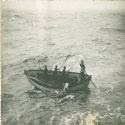 |
| Aerial view of Halifax. |
Arriving in a city for the first time, my priority is to get a feel for where I am and the best way to do that in a short time is to hop on a hop on-off tour bus. There are several here, but our Halifax host and expert, Glenn Bowie, pointed me to the Big Pink bus.
 |
| Big Pink bus. |
Thanks to the tour I saw and learned about ...
Halifax's founding. The native M'kmaq (Mik-maks) called the area shubakta, big harbor.The French came but didn't stay. Some 1,500 settlers arrived in 1749 with Edward Cornwallis and stayed.
 |
| Retrieving bodies at sea. |
 |
| Hearses picking up bodies at the port. |
Halifax and the Titanic. When HMS Titanic sank April 15, 1912, survivors of the disaster were taken to New York. Bodies of those who didn't were searched for in icy waters off the Grand Banks and brought to Halifax. Four Canadian ships, each filled with ice, coffins and carrying a minister and undertaker, had the grisly task of searching and retrieving them. The first ship to return arrived with 190 bodies after burying the remains of 116 souls at sea. The other ships arrived in Halifax with another 209 bodies.
Horse-drawn hearses brought bodies of first class passengers to funeral homes, second and third class passengers to the Mayflower Curling Rink. which had been turned into a temporary morgue. Only 59 bodies were shipped out by train to their families.
In the fall of 1912, residents of Halifax donated flowers, wreaths and services. The White Star Lines set up a fund for cemetery plots and their maintenance for the remaining 466. Most can be found at Fairview Lawn Cemetery.
 |
| Post explosion photo. |
Of the 9,000 residents seriously injured, 200 were blinded; 1,800 people were killed. More than 1,600 homes were destroyed, 1,200 were damaged, and the entire north end of the city evaporated, crumbled into rubble or went up in flames.
Before the day ended, the city of Boston and the state of Massachusetts had dispatched two trainloads of medical supplies and personnel. Some of the doctors and nurses stayed for six months. So grateful were the citizens of Halifax that every year since they find and cut down the most beautiful tree to be found in the surrounding forests and send it to Boston where it is set up near the Prudential Center and lit as close to the fateful date as possible.
Halifax Public Gardens is a classic Victorian-style garden with perimeter open fencing, a pond with geese, serpentine flower gardens and a bandstand.
 |
| The Citadel. |
 |
| Old Town Clock. |
The harbor. The spoon-shaped, deep water harbor, the only one in Canada that doesn't freeze over, is home to the country's largest Navy base. The Halifax shipyards can move 2,200 containers in a 24-hour period and major exports are blueberries, grain, wood and Christmas trees.
Millionaires Row. Young Avenue is where you will see estate-style homes.
 |
| Point Pleasant Park, a real bargain. |
 |
| MacDonald Bridge, no longer cursed. |
 | |
| On the Halifax wharf. |
 |
| Thomas the Tugboat. |


No comments:
Post a Comment